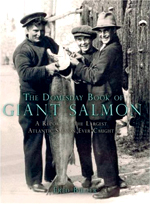Book review: The Domesday Book of giant salmon
David Profumo is hooked by a discursive, lively account of landing wild salmon all over the world.


The Domesday Book of Giant Salmon: A record of the Largest Atlantic Salmon Ever Caught
Fred Buller
(Constable & Robinson, £50)
Last month, there was feverish speculation in the national papers about the true size of a big cock salmon landed and released from the Doch-four stretch of the River Ness; this fascination about large fish even in non-angling circles is duly noted by Fred Buller, whose latest book is the culmination of 40 years spent researching and documenting the capture of Atlantic salmon weighing more than 50lb. The result is a triumph, and solves, at a stroke, the Christmas present problem for any sportsman in your family.
Buller is uniquely admired by the coarse and game fraternities alike, and is, by a country mile, our finest angling historian. In such previous works as The Domesday Book of Mammoth Pike and Freshwater Fishing (his monumental collaboration with the late Hugh Falkus), he has shown his erudition and ingenuity, his gumshoe determination, and his refusal to take anything at face value. This latest book, 480 pages, and weighing in at 5lbs 12oz a hefty specimen in itself is another invaluable contribution to our understanding of the nation's favourite alfresco pastime.
Organised into several categories fly-caught fish, any-method monsters in excess of 60lb, even ones that got away there is a discursive account of the circumstances of each leviathan's capture, ranging from detailed (and sometimes contradictory) first-hand narratives to the sketchiest of historical anecdotes. Buller has truffled out details from the most recherché of sources, including jealously guarded family records, news-paper archives, local museums and the back rooms of inns; evidence is intensely scrutinised, in his inimitably sensible and good-natured style. In one way, therefore, this is an immensely useful documentary book of reference.
What enlivens the whole project, however, and transforms the research into a highly enjoyable volume is the passion for fish and fishing that suffuses this remarkable author's every paragraph. Reviewers tend to recommend such books as being ideal 'to dip into', as if they were some sort of verbal bouillabaisse, but I for one would advise you to start with the Intro-duction and read the entire thing through.
Exquisite houses, the beauty of Nature, and how to get the most from your life, straight to your inbox.
You will learn much along the way how some 98% of these 'portmanteaux' fish are cocks; how Eton beak C. M. Wells bowled out W. G. Grace; how deep-trailing methods are now catching vast Baltic salmon. There are little boys catching monsters on twine, canoes vanishing over rapids, shattered gaff shafts, fraying horsehair lines, and wild tales aplenty. On every page, there seems to be some fresh wonder.
If, like the late poet laureate Ted Hughes, each night of your life you dream about fishing, then the photographs in this book will furnish you with a matchless array of images. Not only are there pictures of the lunkers them- selves the closest thing to salmonid porn I have ever encountered but our author has travelled widely with his own camera, showing us many of the pools where these dramas originally occurred.
In the end, it is the human factor the thrill, the uncertainty and the awe that makes this more than a mere catalogue of records. Mike Crosby landed a massive, but never weighed, Canadian fish in 1988 (he sent me a picture, which appears here as a frontis- piece) and merely commented: 'I know I caught a salmon that no-one else will probably ever catch again, and I'm happy with that.' The words of a true sportsman.
Country Life is unlike any other magazine: the only glossy weekly on the newsstand and the only magazine that has been guest-edited by His Majesty The King not once, but twice. It is a celebration of modern rural life and all its diverse joys and pleasures — that was first published in Queen Victoria's Diamond Jubilee year. Our eclectic mixture of witty and informative content — from the most up-to-date property news and commentary and a coveted glimpse inside some of the UK's best houses and gardens, to gardening, the arts and interior design, written by experts in their field — still cannot be found in print or online, anywhere else.
